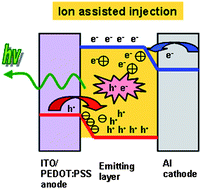Incorporating triphenyl sulfonium salts in polyfluorene PLEDs: an all-organic approach to improved charge injection
Abstract
All-organic sulfonium salts are introduced as a class of ionic compounds that show high compatibility with

* Corresponding authors
a
Institute of Microelectronics, National Centre for Scientific Research “Demokritos”, PO Box 60228, Athens, Greece
E-mail:
argitis@imel.demokritos.gr
b Institute of Physical Chemistry, National Centre for Scientific Research “Demokritos”, Athens, Greece
c Department of Chemical Engineering, National Technical University of Athens, Athens, Greece
d Department of Physics, University of Patras, Patras, Greece
All-organic sulfonium salts are introduced as a class of ionic compounds that show high compatibility with

 Please wait while we load your content...
Something went wrong. Try again?
Please wait while we load your content...
Something went wrong. Try again?
D. G. Georgiadou, L. C. Palilis, M. Vasilopoulou, G. Pistolis, D. Dimotikali and P. Argitis, J. Mater. Chem., 2011, 21, 9296 DOI: 10.1039/C0JM04567E
To request permission to reproduce material from this article, please go to the Copyright Clearance Center request page.
If you are an author contributing to an RSC publication, you do not need to request permission provided correct acknowledgement is given.
If you are the author of this article, you do not need to request permission to reproduce figures and diagrams provided correct acknowledgement is given. If you want to reproduce the whole article in a third-party publication (excluding your thesis/dissertation for which permission is not required) please go to the Copyright Clearance Center request page.
Read more about how to correctly acknowledge RSC content.
 Fetching data from CrossRef.
Fetching data from CrossRef.
This may take some time to load.
Loading related content
